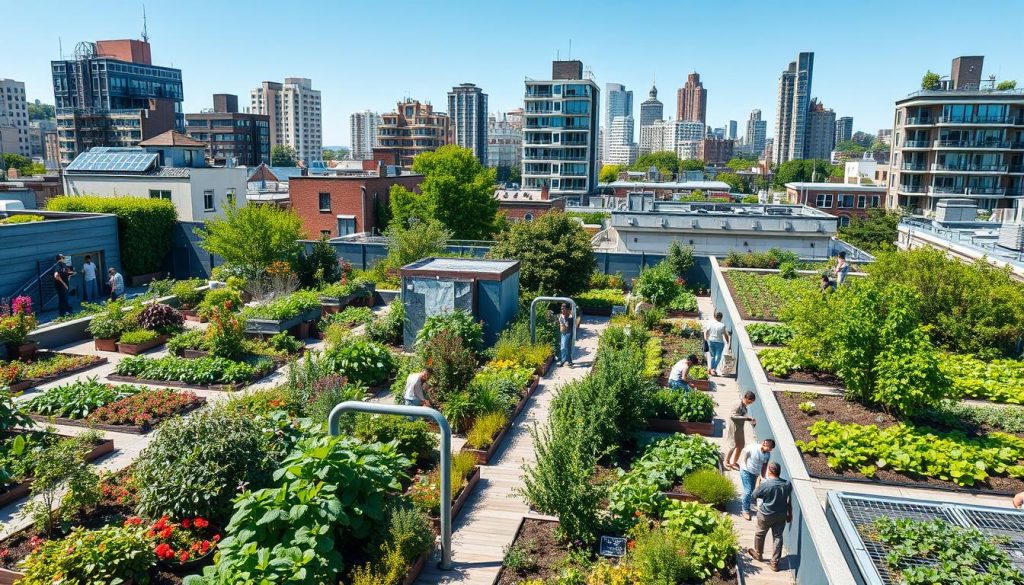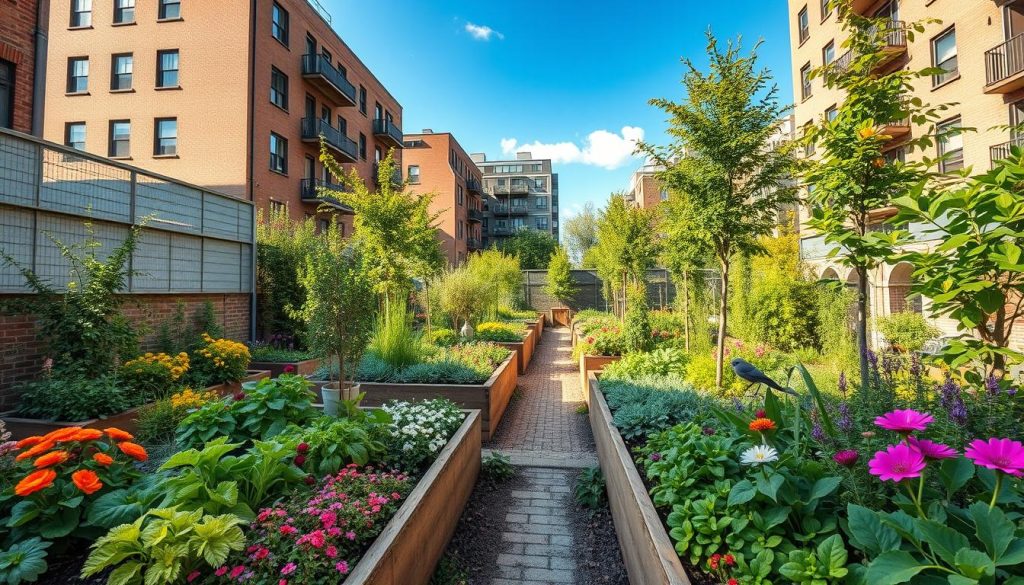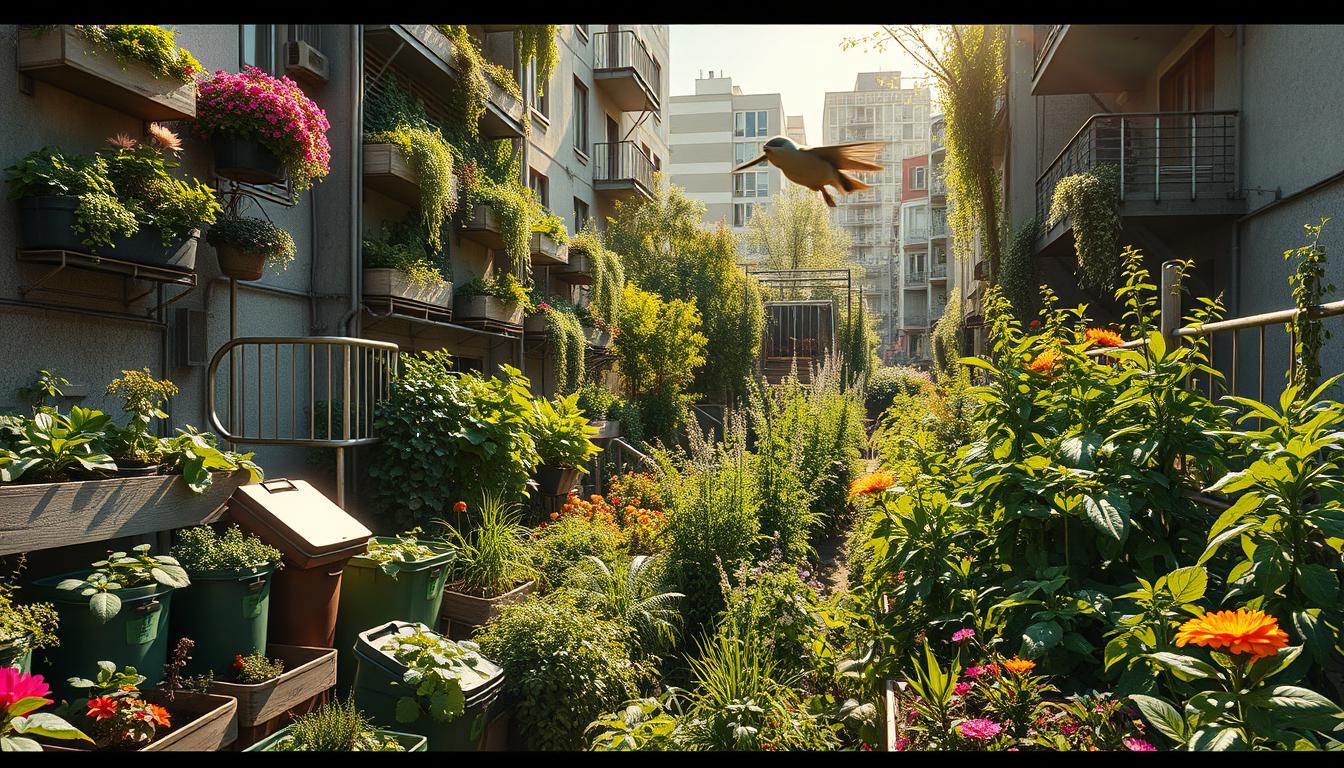Living in the city, I found out how powerful urban permaculture principles are. They turned my small area into a lush, self-sustaining garden. This change not only helped me but also the planet. Permaculture design was key to this transformation, and I’m excited to share it with others.
Urban permaculture principles made my small urban space a green oasis. I’m eager to inspire others to do the same. By using permaculture design, I’ve cut down my environmental impact and helped create a greener future.
My journey with urban permaculture taught me the value of living sustainably in the city. I hope my story will motivate others to try permaculture design and principles. Together, we can make our communities more sustainable.
What is Urban Permaculture?
Urban permaculture is a way to design sustainable cities. It focuses on growing food in cities and connecting with nature. It also involves planning cities that work with the environment, not against it.
Urban gardening is key in urban permaculture. It lets people turn their spaces into gardens. This way, they can grow their own food and live more sustainably.
Defining Permaculture in an Urban Context
Permaculture is about making ecosystems sustainable. In cities, it means making places that are good for the environment, fair for people, and work well economically. This is done through urban farming, city planning, and gardening.
Core Principles of Permaculture
The main ideas of permaculture are caring for the earth, people, and sharing. These ideas help cities be green, fair, and connected. They make cities better for everyone.

The Importance of Sustainability
Sustainability is central to urban permaculture. It means using less, saving water, and using green energy. This makes cities better for the planet and people. Urban permaculture shows us how to build a future where cities and nature work together.
My First Steps into Urban Gardening
Starting my urban gardening journey, I learned how key eco-friendly practices are. These practices help make gardens sustainable and productive. I focused on reducing waste and saving water, important for my garden.
I looked at my space carefully, thinking about sunlight, soil, and how easy it was to get to. This was my first step in planning my garden.
Choosing the right spot was essential for my garden’s success. I picked a place with lots of sunlight and good drainage. Then, I worked on the soil, knowing healthy soil is crucial for plants.
I used eco-friendly methods like composting and natural fertilizers. This made my soil rich and ready for my plants to grow.
Key Considerations for Urban Gardeners
- Assessing available space and selecting the right location
- Preparing and managing soil nutrients for optimal plant growth
- Implementing eco-friendly urban practices, such as rainwater harvesting and composting
By starting with these steps and embracing permaculture, I built a thriving garden. I’m eager to learn more and share my journey. I hope to inspire others to start their own urban gardens and enjoy the benefits of permaculture.
Designing My Urban Permaculture Garden
When I started designing my urban permaculture garden, I thought a lot about growing food in the city and being green. I wanted a garden that could feed me and help the planet at the same time.
Layout and Zoning
I worked hard on the garden’s layout and zoning. I split it into zones for veggies, fruits, and compost. This way, I used space wisely and cut down on waste.
Companion Planting Strategies
I used companion planting to help my plants grow better together. For instance, I put marigolds with tomatoes to keep nematodes away. Basil with lettuce made the lettuce taste better. This made my garden healthier and more productive.

Incorporating Edible Landscapes
I also made my garden beautiful by using edible plants as ground cover. Herbs and leafy greens not only looked good but also gave me fresh food all the time. By doing this, I made a garden that shows how great urban farming and green living can be.
Water Management Techniques
My journey towards sustainable urban living has shown me how vital water management is. It’s about cutting down waste and saving water. By using water wisely, I help the planet and create a self-sustaining garden.
In urban gardens, managing water is key to keeping things healthy. There are many ways to do this, like:
- Rainwater harvesting: collecting and storing rainwater for non-potable uses like watering plants and flushing toilets
- Greywater recycling: using water from sinks, showers, and washing machines for plants
- Efficient irrigation methods: using drip irrigation and mulching to save water
By using these methods, my garden becomes more sustainable and strong. It’s good for the planet and makes me feel connected to nature. I’m eager to share what I’ve learned with others, hoping to inspire them to live sustainably.

Local Community and Urban Permaculture
Exploring urban permaculture showed me how vital a strong local community is. It’s not just about growing food. It’s about building a network of people who share knowledge and support each other. Together, we can make a more sustainable food system that helps everyone.
Creating community gardens and shared spaces is a great way to start. These areas let urban growers share ideas and learn from each other. By using urban permaculture, we can make these spaces efficient, productive, and good for the environment.
Benefits of Community Gardens
- Increased food production and access to fresh produce
- Opportunities for education and skill-sharing
- Community building and social connections
- Environmental benefits, such as reduced waste and increased biodiversity
By following urban permaculture and urban agriculture, we can build a better food system. It’s one that’s good for people and the planet. I hope to inspire others to join me in building a stronger, more connected community of urban growers.
Challenges I Faced and Overcame
As I worked on my urban permaculture garden, I hit many hurdles. One big challenge was the limited space. I had to get creative and use new ways to garden in the city. I started using vertical and container gardening to make the most of my space.
Here are some strategies I used to beat these challenges:
- Utilizing walls and fences to create vertical gardens
- Implementing companion planting to reduce pests and diseases
- Using rainwater harvesting and greywater recycling to conserve water
Dealing with Limited Space
Thanks to these techniques, my small space became a productive garden. I found out that with a bit of creativity and hard work, you can overcome any obstacle. This way, you can create a thriving urban permaculture garden.
Pest Control in Urban Environments
Managing pests in the city was another challenge. I had to find natural ways to keep pests away. By doing so, I kept my garden healthy and balanced.
The Future of My Urban Permaculture Journey
I’m excited for what’s next in my urban permaculture journey. I aim to grow my garden more and share what I’ve learned. Urban permaculture has made growing food sustainable and productive. I want to encourage others to join this movement.
Expanding My Garden
I plan to make my garden bigger, using urban sustainability strategies to improve it. I’ll use vertical gardening and new container gardening ideas. This will help me fit more plants in my small space.
Sharing Knowledge and Resources
I want to share what I’ve learned with my community. I’ll host workshops, create educational materials, and work with other gardeners. Together, we can make our food system more sustainable and strong.
Inspiring Others to Join the Movement
My journey with urban permaculture has changed me for the better. I hope to inspire others to start their own journey. By showing the good results and benefits, I aim to get more people involved in urban sustainability strategies and urban permaculture.

